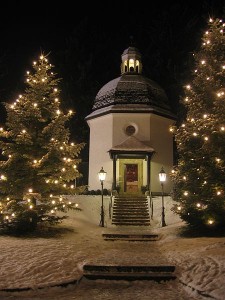
Photo:Gakuro
Silent Night(Stille Nacht in German, Silens Nox in Latin) is perhaps the most beloved Christmas Carol. It was composed in 1818 by Franz Guber, an organist and schoolmaster, to lyrics by Father Joseph Mohr of the St. Nicholas parish in Oberndorf bei Salzburg, Austria. It was first performed on Christmas Eve in 1818 and since the organ was broken, the only musical accompaniment was the guitar. The popularity of the song spread and the version commonly used today comes from a translation in 1859. John Freeman Young, serving as an Episcopal priest at Trinity Church in New York City, translated and changed the tempo of the song. The original rendition by Gruber was more like a dance tune and sung faster. Young made into a slower lullaby style that is the most common version today. Because it has been so widely translated, it is the one Christmas carol that is known worldwide.
In Austria Silent Night is not heard until Christmas Eve, usually around 9 p.m. Then it is played on the radio once an hour and of course during church services.
Silent night, Holy Night
All is calm, all is bright
round yon Virgin Mother and Child,
Holy infant so tender and mild,
sleep in Heavenly peace!
sleep in Heavenly peace!
Silent night! Holy night!
Shepherds quake at the sight;
glories stream from Heaven afar,
Heavenly hosts sing Alleluia,
Christ, the Saviour, is born!
Christ, the Saviour, is born!
Silent night! Holy night!
Son of God, Love’s pure light
radiant, beams from Thy Holy face,
with the dawn of redeeming grace,
Jesus, Lord at Thy birth,
Jesus, Lord at Thy birth.
(In German)
Stille Nacht! Heilige Nacht!
Alles schläft; einsam wacht
Nur das traute hoch heilige Paar.
Holder Knab’ im lockigen Haar,
Schlafe in himmlischer Ruh!
Schlafe in himmlischer Ruh!
Stille Nacht! Heilige Nacht!
Gottes Sohn, o wie lacht
Lieb’ aus deinem göttlichen Mund,
Da uns schlägt die rettende Stund’.
Jesus in deiner Geburt!
Jesus in deiner Geburt!
Stille Nacht! Heilige Nacht!
Die der Welt Heil gebracht,
Aus des Himmels goldenen Höhn,
Uns der Gnaden Fülle läßt sehn,
Jesum in Menschengestalt!
Jesum in Menschengestalt!
,,




